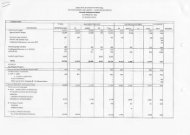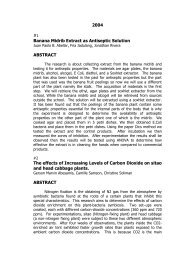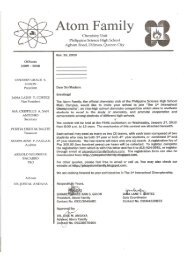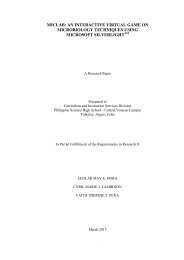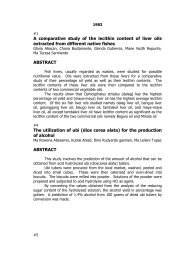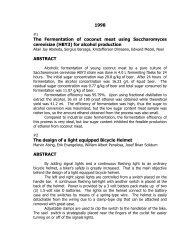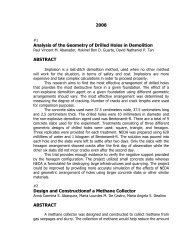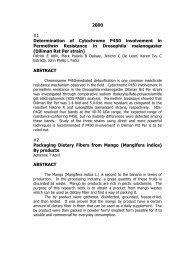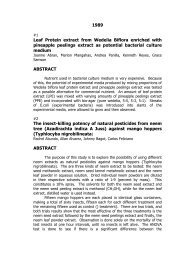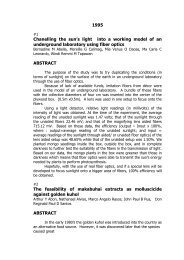A comparative study of paper produced from zea mays - Philippine ...
A comparative study of paper produced from zea mays - Philippine ...
A comparative study of paper produced from zea mays - Philippine ...
Create successful ePaper yourself
Turn your PDF publications into a flip-book with our unique Google optimized e-Paper software.
however, proved that there were no significant differences between the<br />
amounts <strong>of</strong> gas <strong>produced</strong> by the experimental groups.<br />
#42<br />
Horse manure as a substitute for wood charcoal<br />
Dante del Rosario, Andrew Fañega, Farley Aguila, Raymond Santiago, Carlos<br />
Espiritu<br />
ABSTRACT<br />
The <strong>study</strong> aimed at the technical feasibility <strong>of</strong> producing charcoal <strong>from</strong><br />
horse manure using locally available binder-corn starch. Briquettes with<br />
cornstarch mixture binder had higher crushing strength compared to<br />
briquettes can then be made into charcoal by simply drying the materials to<br />
constant weight. The amount <strong>of</strong> heat emitted per volume results indicated<br />
that the production <strong>of</strong> charcoal briquettes <strong>from</strong> horse manure is feasible using<br />
cornstarch. But the heating capacity <strong>of</strong> pure manure is greater than the<br />
heating capacity <strong>of</strong> the manure with cornstarch as binder. The product can<br />
only be used as a source <strong>of</strong> energy for incubators.<br />
#43<br />
Improving the quality <strong>of</strong> cheese made <strong>from</strong> mixed mold<br />
rennet extracts<br />
Lani Rose San Mateo, Joey Roque Boiser, Afzelia Thersa Busa, Abelardo Perez<br />
Jr, Lynn Redoble<br />
ABSTRACT<br />
Mold extracts <strong>from</strong> Aspergillus niger (strain 3704) cultured in potato<br />
dextrose agar (PDA) and Czapek-dox agar (CDA); and Rhizopus oryzae (strain<br />
3356) cultured in rice bran (RB) and copra meal (CM) were combined in five<br />
different ratios, producing 16 combinations <strong>of</strong> mixed mold rennet extract.<br />
These 16 combinations were reduced to two best combinations for<br />
cheesemaking based on milk clotting activity (MCA) milk clotting time (MCT)<br />
and percentage yield, namely: 5.0 Cm : 5.0 CDA and 5.0 CM : 5.0 PDA.<br />
Cost analysis showed that the experimental samples at P14.64/100 g<br />
and 13.74/100 g (treatments with and without lactic acid, respectively were<br />
more expensive than the control at 8.00/100g. However, with the use <strong>of</strong><br />
carabao’s milk, costs may be substantially reduced.<br />
Addition <strong>of</strong> lactic acid <strong>from</strong> Streptococcus sp. showed no effects on<br />
shelf life and did not significantly affect the percentage yield. Furthermore,<br />
there was no recognizable trend in terms <strong>of</strong> crude protein and fat content, but<br />
the general acceptability <strong>of</strong> cheese made <strong>from</strong> mixed mold rennet extracts<br />
was improved.<br />
The Wilcoxon’s signed-rank test showed that the most acceptable<br />
proportion for cheesemaking is 5.0 CM: 5.0 CDA with lactic acid. Its crude fat<br />
content (9.42%) ranked highest among the experimental samples and only



